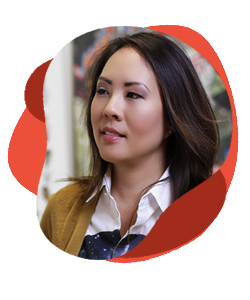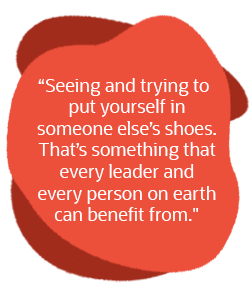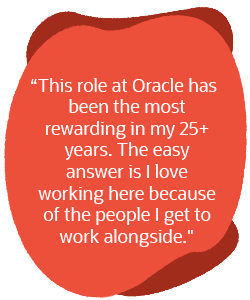Senior Vice President of UX Design, Jenny Lam is uniquely placed within Oracle. UX exists at the point where products and solutions meet the people that r ely on them. For most users, it’s their first impression of that product and their whole perception of Oracle could hinge on it. With one eye on design and the other on user experience, Jenny needs to constantly question technology’s relationship with the human factor.
ely on them. For most users, it’s their first impression of that product and their whole perception of Oracle could hinge on it. With one eye on design and the other on user experience, Jenny needs to constantly question technology’s relationship with the human factor.
It sounds complex, but when Jenny reflects on her role, she gets right back to basics: “We’re aiming to get people to fall in love with Oracle one interaction at a time,” she says.
More than designing a user experience, Jenny and her team craft relationships that answer our customers’ needs now and in future. This approach takes some novel thinking.
Clarity of purpose
“It all starts with falling in love with the problem versus the solution,” Jenny shares. “Understanding and anticipating the needs, desires, and nuances of our customers. We call that here at Oracle: ‘clarity of purpose’. We have training and workshops and a whole way to make sure we’re really understanding the users’ goals and not needlessly creating features that don’t actually impact the problem.”
In practice, this requires a stripped back way of thinking that puts users and effectiveness first. To stay grounded, Jenny considers each enterprise tool as it relates to the customer, likening them to a craftsperson’s tools: elegant and reliable, but always effective.
“Once that’s established, we combine the most minimal interaction design with the magic of emotional design (visual, motion, and even automatically doing things on behalf of the customers) to deliver a consumer-grade experience that is a joy to use. Far too often enterprise tools have been given a pass at really making using software a joy to use.”
“Much like a chef with her favorite knife or carpenter with their beloved tools, they get the job done with quality but are also wonderful to use.”
Big changes
It’s wisdom born of experience. Previously, she served as design director in Amazon’s Devices group, where she crafted digital and voice experiences on FireTV, Fire Tablets, and Echo products. Before that, she was cofounder of Jackson Fish Market, a design and digital transformation agency that she built with longtime colleague Hillel Cooperman. Before Jackson Fish Market, she worked at Microsoft from 2001 to 2007 as creative director of the Windows User Experience team.
No stranger to the tech space, Jenny joined Oracle on the recommendation of an old colleague in 2018.
“I didn’t really know much about Oracle before joining. But what I did know was that the incredible designer Hillel Cooperman was working here six months prior to me and telling me that the company wanted to make big changes and they were looking to Design to help them do that.”
Empathy
Now, she’s using design thinking to shape products with global impact. The approach takes a questioning, playful approach to problem-solving normally seen in the creative fields and lets them loose on all kinds of challenges.
“It’s so beautiful how design thinking and clarity of purpose has gotten more attention in disciplines outside of design. At the heart of it, it’s about empathy,” she says. 
It’s something that also informs her leadership style and keeps her close to the latest developments.
“Although I coach teams to do their best, I also can roll up my sleeves when necessary and pitch in. This balance for me lets me not get too far away from my craft and helps me get a pulse of the day-to-day field work.”
Feeling safe and seen
Away from the work, she sees leadership as a willingness to lead the conversation. Something that’s especially valuable when it comes to modeling awareness around diversity and inclusion.
“Sometimes we shy away from talking about diversity but as leaders who are building and developing teams, it’s up to them to model and bring more conversation to the forefront. The more we get comfortable talking about diversity and inclusion, the more it becomes an essential part of building better products and services for our customers and growing and developing our teams.”
This leads to better products capable of addressing diverse needs and makes Oracle a safe harbor for people of all backgrounds.
“Diversity and inclusion and equity to me means everyone feeling safe and seen,” Jenny continues. “The more feeling of safety and being recognized and understood, the more we can be less stressed and focus on letting our true talents shine through.”
Rewarding
It’s something Jenny has firsthand experience of as an Asian American leader. And it has a special resonance during Asian American and Pacific Islander Heritage Month.
“When I was younger, I wanted to assimilate and ‘fit in’ with everyone else. Today, I see it as an asset to represent and honor the influence, culture, and history that Asian Americans and Pacific Islanders has brought into the modern day. There’s so much to be proud of.”
Jenny is actively engaged in sharing her design ideas across the industry and has served on the national board of directors for the American Institute of Graphic Arts (AIGA), the Professional Association of Design and mentors national and local organizations to foster the next generation of creative talent in tech.
She has also chaired and judged for the Smithsonian Cooper-Hewitt Design Museum National Design Awards among others. With all this in mind, she’s well-placed to offer her take on life at Oracle.
“This role at Oracle has been the most rewarding in my 25+ years. The easy answer is I love working here because of the people I get to work alongside. The talented and open teams at Oracle make it so easy to come to work every day.”
Would you like to work and thrive alongside leaders who see the tech sector differently? Explore our open roles and help us create a better future for everyone.
